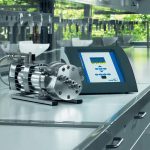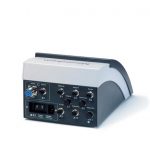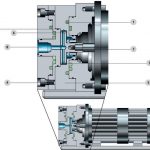Die Kreiselpumpe Microchem stellt der chemischen Industrie, insbesondere der Mikroverfahrenstechnik, einen pulsationsfreien, flexibel einstellbaren Förderstrom zur Verfügung. Die Pumpe zeichnet sich durch kleine Fördermengen bei großer Förderhöhe und einem breiten Betriebsbereich aus. The Microchem centrifugal pump answers the need of the chemical industry, and the field of micro-process engineering in particular, for a pulsation-free, adjustable flow rate. The pump is capable of conveying smallest flow rates at high heads across a broad operating range.
Um die Anforderungen an eine Pumpe für die kontinuierliche Prozesstechnik auch bei sehr kleinen Mengen zu erfüllen, entwickelte KSB zusammen mit der chemischen Industrie und Spezialisten aus dem Bereich Mikroverfahrenstechnik eine Pumpe mit einer speziell angepassten Regelung. Die Microchem ist als Kreiselpumpe ausgeführt. Die Herausforderung in der Entwicklung bestand darin, kleine Förderströme bei vergleichsweise hohen Drücke zu ermöglichen. Die Verwendbarkeit als Kleinstmengenförderpumpe erreichte man in erster Linie durch eine extreme Verkleinerung des Laufrads und einer deutlichen Drehzahlanhebung. Die Bauart des Laufrads ist auf pulsationsfreie Förderung hin optimiert. Aufgrund der sehr kleinen Fördermengen der Pumpe ergeben sich niedrige Fließgeschwindigkeiten innerhalb des Laufrads. Mit seiner geringen radialen Erstreckung ist das Laufrad auf einen zuverlässigen hohen Druckaufbau ausgelegt. Die Hydraulik der Microchem ist nicht wie üblich auf einen optimalen Betriebspunkt hin entwickelt, sondern auf ein möglichst großes Kennfeld. Um den Betriebsbereich nicht nur hinsichtlich des Volumenstroms, sondern auch hinsichtlich der Förderhöhen sehr groß zu gestalten, wurde als Antrieb ein geregelter EC-Motor gewählt. Dieser Antrieb erlaubt ein Drehzahlspektrum von wenigen 100 bis mehreren 1000 min-1. Außerdem ist durch diesen Motortyp eine sehr genaue Ansteuerung einer bestimmten Drehzahl möglich, und er verfügt über eine hohe Drehzahlstabilität. Das sorgt für einen präzisen und konstanten Förderstrom. Die an der Entwicklung beteiligten Anwender legten nicht nur Wert auf eine Druckerhöhung des Fördermediums, sondern auch auf die Möglichkeit, den gewünschten Förderstrom präzise und einfach einzustellen. Die Microchem Control Unit bietet neben der für die Ansteuerung des EC-Motors notwendigen Elektronik eine integrierte Regelung. Der Regelalgorithmus sorgt in Kombination mit dem regelbaren Antrieb und einem externen Durchflussmesser für eine hohe Genauigkeit bei der Einstellung und Einhaltung eines Volumenstromes innerhalb des Pumpenkennfelds. Als Durchflussmessung sind die jeweils kundenspezifisch verwendeten Geräte geeignet. Im Gegensatz zu einer konventionellen Kreiselpumpe wird der Volumenstrom nicht über eine Drosselung, sondern ausschließlich über Drehzahlveränderung eingestellt. Eine Regelarmatur entfällt. Nach Eingabe des gewünschten Volumenstroms stellt die Microchem selbstständig den geeigneten Betriebspunkt innerhalb des Kennfelds ein. In automatisierten Anlagen oder Prozessen kann die Microchem über Analogsignale, ModBus oder Profibus DP von einer übergeordneten Prozessleittechnik angesteuert werden. Der Grad der Systemintegration kann frei gewählt werden. Er reicht von externer Vorgabe eines Sollvolumenstromes bis hin zur Vorgabe des Drehzahlsollwertes. Entsprechend liegt die Volumenstromregelung bei der Microchem Control Unit oder bei einer übergeordneten kundenspezifischen Automation.
Eine Baugröße für Labor, Technikum und Produktion
Die Kombination aus Kreiselpumpe und Regelung ermöglicht einen Förderstrombereich von 1 bis 5000 ml/min bei bis zu 25 bar Förderdruck. Dabei deckt nur eine Baugröße das gesamte Kennfeld ab. Das erlaubt den Einsatz derselben Pumpe sowohl im Labor während der Prozessentwicklung als auch bei der technischen Umsetzung im Technikum und anschließend in der Produktion. Damit ist sichergestellt, dass die im Labor erzielten Ergebnisse eins zu eins in die Produktion übertragbar sind. Eine automatische Benutzerführung zur Abstimmung der Microchem an die jeweilige Arbeitsumgebung gewährleistet die einfache Anbindung bei verschiedenen Anforderungen in Labor, Technikum und Produktion. Für den Betrieb im Labor ist neben den kleinen Volumenströmen das geringe Füllvolumen der Pumpe von circa 5 ml von Vorteil. Zudem ist die Pumpe CIP-fähig. So kann sie mit wenig Spülmedium und minimalem Verlust an Edukt in kurzer Zeit gereinigt werden. Als Werkstoff kommt für die vom Fördermedium berührten, metallischen Bauteile das chemisch resistente Material 1.4571 oder wahlweise Hastelloy C zum Einsatz. Die statischen Dichtungen sind aus Kalrez Spectrum ausgeführt. Die robuste Bauweise erlaubt auch den Dauerbetrieb in Produktionsanlagen. Im Fördermedium enthaltene Partikel wie Kristalle oder Verschmutzungen führen nicht zum sofortigen Ausfall der Pumpe. Eine optional erhältliche Wellendichtung in Quench-Ausführung erlaubt das Fördern von gefährlichen oder giftigen Medien. Ebenso senkt das kleine Füllvolumen der Pumpe das potenzielle Sicherheitsrisiko innerhalb einer Anlage.
Zur Förderung von Medien mit hohem Schmelzpunkt oder mit niedrigem Siedepunkt ist eine Fluidtemperierung in die Pumpe integriert. Durch Anschluss eines Thermo- oder Kryostaten kann der Betreiber die Temperatur des Fördermediums in der Pumpe einstellen. In der Standardausführung ist die Pumpe in der Lage, Medien in einem Temperaturbereich von -10 bis +100 °C zu fördern. Der Zugang zum Pumpenraum ist in einem einzigen Arbeitsschritt durch Lösen von vier Schrauben möglich. Das Laufrad lässt sich in einem zweiten Schritt durch Herausdrehen sehr einfach demontieren. So kann der Anwender die Pumpe schnell und unkompliziert inspizieren und bei Bedarf alle fluidberührten Teile mechanisch oder im Ultraschallbad reinigen.
To meet the requirements of a pump for continuous process management even of very small quantities, KSB joined forces with the chemical industry and specialists from the micro-process engineering field to develop a pump with an integrated control system. Microchem is a centrifugal pump by design. What made its development challenging was the need to combine the pulsation-free property with that for small capacities and comparably high pressures. The Microchem is a combination of a new technical approach and a number of innovative details. Its suitability as a pump for transporting smallest quantities was first of all achieved by significantly reducing the impeller size and increasing the rotational speed. The impeller design was optimised in respect of pulsation-free delivery. The very small flow rates of the pump make for low flow velocities within the impeller. Designed with a very short radial passage, the impeller is ideally suited for a dependable, high pressure build-up. Contrary to other new pump developments, designing the hydraulic section of the Microchem did not aim at achieving the optimum duty point, but as broad a performance range as pos-sible. To make sure of this, both in respect of the pump’s volume flow rate and of the achievable head, a speed-controlled EC-motor was selected to serve as drive. The speed spectrum of this drive ranges from several hundred to several thousand revolutions per minute. It also allows the required speed to be set very precisely, and shows great speed stability. In turn, these features warrant a precise and consistent pump output. The users who had participated in the product’s development had indicated that they were not just looking for a unit that would boost the pressure of the fluid pumped but also for an easy-to-operate means of accurately setting the desired flow rate. The Microchem Control Unit does not just contain the electronics needed to adjust the speed of the EC-motor but also an integrated control device. In combination with an accurately controllable drive and an external flow meter, the integrated control algorithm provides for a precise setting and mainte-nance of the flow rate within the pump’s performance range. Flow measurement can be done with the flow meter used by the customer. In contrast to a conventional centrifugal pump, the volume flow is not adjusted by means of throttling, but only by changing the speed of rotation. There is no need for a control valve. The Microchem Control Unit has been designed for easy and uncomplicated handling. The user does not require any special knowledge of pump or system characteristics, the required speed or the exact duty point. After keying in the required flow rate, the Microchem automatic-ally selects the suitable duty point within the pump’s performance range. In automated systems or processes, the Microchem can be controlled from a higher process control system through analogue signals, a ModBus or Profibus DP. The user is free to choose the degree of integration in the existing system. It ranges from external setpoint selection of the required flow rate to entry of the required speed. Accordingly, the flow is either controlled by the Microchem Control Unit or by the customer’s plant process control system.
One size for laboratory, pilot plant and production facility
The unit comprising a centrifugal pump and a control unit is capable of handling flow rates from 1 to 5,000 ml/min at up to 25 bar discharge pressure. It comes in one size only for the entire performance range. This means the same pump can be used in the lab during process development, for trial operation in the pilot plant, and subsequently for every-day production. It also means that the results obtained in the lab will be exactly the same in the production process. Besides the small flow rates of approximately 5 ml, the small filling volume of the pump also is a great advantage. This makes it suitable for work using the smallest amount of fluid. A further advantage of the pump is its CIP-feature, i.e. it can be cleaned in place. This means that the pump can be cleaned with a small amount of cleaning liquid and that only a small amount of the fluid pumped is lost in the process. Chemically resistant steel type 1.4571 or, as an option, Hastelloy C are used for the metal parts coming into contact with the fluid pumped. All static seals are made of Kalrez Spectrum.
Thanks to the robustness of the pump, it is also suitable for continuous operation in production facilities. The proper functioning of the pump unit does not depend on sensitive or wear-prone, geometrically close-fit contours. Particles contained in the fluid pumped, such as crystals or dirt, will not cause the pump to immediately fail. Based on its broad performance range and its CIP-capability, the pump is ideally suited for service in multi-purpose systems. Fitted with an optional shaft seal in so-called quench design, the pump can be safely used for hazardous or toxic fluids. The small filling volume required by the pump further reduces the potential safety risk of a system. The pump has fully integrated tempering channels for fluids with a high melting point or a low boiling point. After hooking up the pump to a thermostat or kyrostat, the user is able to set the fluid temperature in the pump. Executed in the standard design, the pump is capable of handling fluids with a temperature from -10 to +100 °C. It takes no more than a single operation, i.e. unscrewing of four bolts, to gain access to the pump chamber. To remove the impeller, it is simply screwed out. Having completed these two steps, the user can, if required, clean the wetted parts either by mechanical means or in an ultrasound bath. In production, this design feature means that downtimes for service, maintenance or inspections can be kept very short.
Top Products 430
Microchem pump
Institute for Micro Process Engineering
Industrial Panel Micro Process Engineering
Unsere Webinar-Empfehlung
Die Websession „Wasserstoff in der Chemie – Anlagen, Komponenten, Dienstleistungen“ (hier als Webcast abrufbar) zeigt technische Lösungen auf, die die Herstellung und Handhabung von Wasserstoff in der chemischen Industrie sicher machen und wirtschaftlich gestalten.
Ob effizienter…
Teilen:













